#Salon du Louvre
Text

L'origine du mot "Vernissage"
B. Perat - Vernissage au salon, Paris 1866
#vernissage#Paris#Louvre#musée#musée du Louvre#Salon#Salon du Louvre#Salon carré#museum#exhibition#art
3 notes
·
View notes
Text

François Boucher (French, 1703-1770)
Psyché et l'Amour, Salon de 1798
Musée du Louvre
#François Boucher#french#french art#france#art#fine art#european art#classical art#1700s#psyche et l'amour#europe#european#oil painting#blonde#greek mythology#mythology#mythological art#fine arts#europa#mediterranean
84 notes
·
View notes
Text

Jacques-Albert Senave - Copyist in a gallery of the Louvre -
oil on panel, height: 28.5 cm (11.2 in); width: 36.2 cm (14.2 in)
Louvre Museum
The Louvre or the Louvre Museum is a national art museum in Paris, France. It is located on the Right Bank of the Seine in the city's 1st arrondissement (district or ward) and home to some of the most canonical works of Western art, including the Mona Lisa and the Venus de Milo. The museum is housed in the Louvre Palace, originally built in the late 12th to 13th century under Philip II. Remnants of the Medieval Louvre fortress are visible in the basement of the museum. Due to urban expansion, the fortress eventually lost its defensive function, and in 1546 Francis I converted it into the primary residence of the French kings.
The building was extended many times to form the present Louvre Palace. In 1682, Louis XIV chose the Palace of Versailles for his household, leaving the Louvre primarily as a place to display the royal collection, including, from 1692, a collection of ancient Greek and Roman sculpture. In 1692, the building was occupied by the Académie des Inscriptions et Belles-Lettres and the Académie Royale de Peinture et de Sculpture, which in 1699 held the first of a series of salons. The Académie remained at the Louvre for 100 years. During the French Revolution, the National Assembly decreed that the Louvre should be used as a museum to display the nation's masterpieces.
The museum opened on 10 August 1793 with an exhibition of 537 paintings, the majority of the works being royal and confiscated church property. Because of structural problems with the building, the museum was closed from 1796 until 1801. The collection was increased under Napoleon and the museum was renamed Musée Napoléon, but after Napoleon's abdication, many works seized by his armies were returned to their original owners. The collection was further increased during the reigns of Louis XVIII and Charles X, and during the Second French Empire the museum gained 20,000 pieces. Holdings have grown steadily through donations and bequests since the Third Republic. The collection is divided among eight curatorial departments: Egyptian Antiquities; Near Eastern Antiquities; Greek, Etruscan, and Roman Antiquities; Islamic Art; Sculpture; Decorative Arts; Paintings; Prints and Drawings.
The Musée du Louvre contains approximately 500,000 objects and displays 35,000 works of art in eight curatorial departments with more than 60,600 m2 (652,000 sq ft) dedicated to the permanent collection. The Louvre exhibits sculptures, objets d'art, paintings, drawings, and archaeological finds. At any given point in time, approximately 38,000 objects from prehistory to the 21st century are being exhibited over an area of 72,735 m2 (782,910 sq ft), making it the largest museum in the world. It received 8.9 million visitors in 2023, 14 percent more than in 2022, but still below the 10.1 million visitors in 2018, making it the most-visited museum in the world.
Jacques-Albert Senave (1758–1823) was a Flemish painter mainly active in Paris during the late 18th and early 19th centuries. He is known for his genre scenes, history paintings, landscapes, city views, market scenes and portraits.
23 notes
·
View notes
Text

Dans la rue de l’Espérance, on aperçoit encore le salon du vieux Fernand, qui officiait en artiste du peigne et du ciseau. « Coiffeur », dit encore l'enseigne, se faisant l’écho d'un temps où on venait se faire tondre en parlant mistral et bourrasques. Sa boutique c'était pas le Louvre, mais chaque coup de ciseau était un coup de pinceau, chaque mèche tombée, une œuvre d'art éphémère. « Les cheveux blancs, c'est les souvenirs qui poussent » qu'il disait de sa voix rocailleuse résonnant sur les murs écaillés. Ses mains, secouées de tremblements, tissaient des coiffures comme on noue des amitiés : serrées, solides et un brin compliquées. Sa vitrine était cachée derrière un rideau plus orange qu’un soleil couchant. « La discrétion, mes enfants, c'est la clef de l'élégance, » qu'il affirmait, le Fernand, alors que c'était surtout pour masquer la poussière qui s'accumulait. Le soir, après avoir rangé ses rasoirs et ses flacons d'après-rasage qui sentaient le vieux temps, il s'asseyait sur le seuil de sa boutique et tirait sur sa pipe en bois d'ébène. « Un coiffeur, mes gosses, c'est plus qu'un artisan, c'est le psy du pauvre, le confesseur du dimanche, le témoin silencieux des vies qui défilent. » Et sur ces pensées, il écrasait son mégot contre le pavé, dans un geste aussi définitif que la fermeture imminente de son salon. Aujourd’hui, au premier, les géraniums de la veuve Dupont, s'épanouissent comme les rumeurs du quartier. « C'est beau, hein ? » qu'elle lance, tête penchée au dehors, « ça donne de la couleur, un peu comme un sourire en plein enterrement. » Un passant, un vieux du quartier qui a connu Fernand, s'arrête un instant et lève les yeux en répliquant : « C'est sûr, madame Dupont, et avec tout ce rouge, on dirait presque que les géraniums se sont mis à boire plus que Fernand à ses belles heures ! » Elle rit en se remémorant le coiffeur et son don pour l'éloquence subtile. Elle l’imagine lâcher : « Vos géraniums, Madame Dupont, sont un peu les cheveux roux de la rue. Ils mettent du panache au quartier, tout comme une rousse incendiaire dans un congrès de chauves. »
23 notes
·
View notes
Photo

Maurice-Quentin de La Tour (1704-88), Louis XV, Salon 1748, Musée du Louvre
87 notes
·
View notes
Text
Magdalena-Bay, par François BIARD
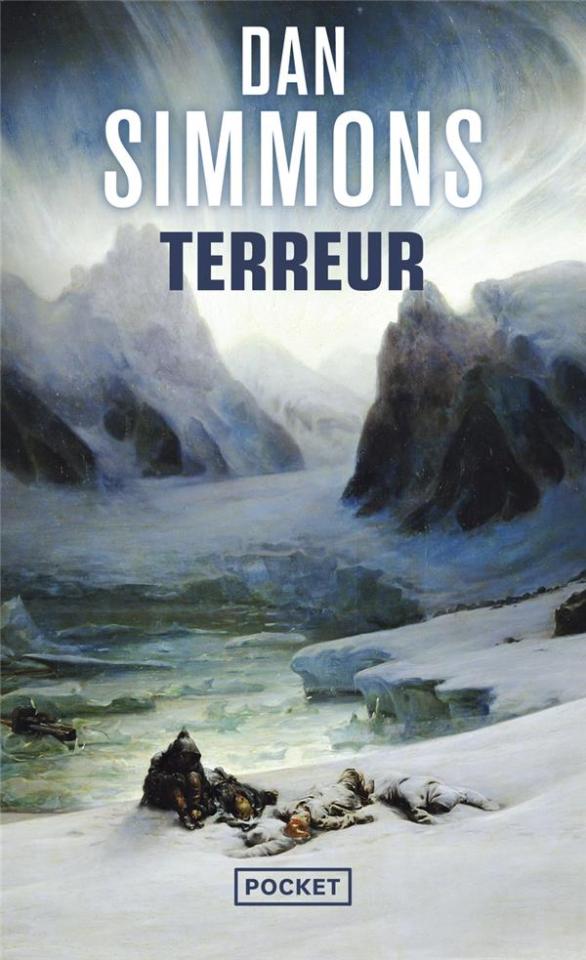
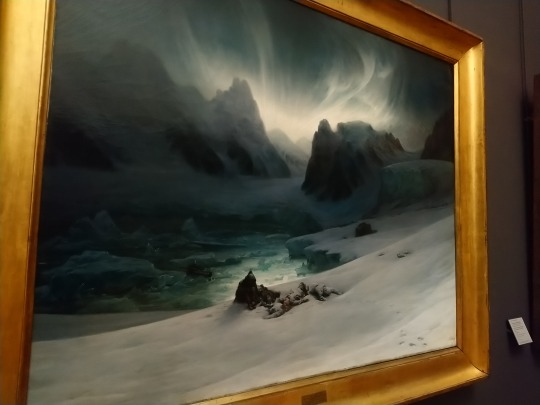
Si vous passez par le Louvre, n'hésitez pas à vous arrêter devant ce magnifique paysage, caché dans une petite salle au dernier étage de l'aile Sully. Les photos ne lui rendent pas justice, le travail des couleurs est excellent et le tableau est présenté à notre hauteur, comme si on faisait partie de la scène.
→ Salle 946, aile Sully, niveau 2
(Attention, regardez bien les jours d'ouverture des salles! Tout n'est pas tout le temps ouvert)
Magdalena-Bay, vue prise de la presqu'île des Tombeaux, au nord du Spitzberg; effet d'aurore boréale.
Acquis au Salon de 1841
François Biard
Huile sur toile, 1,3m/1,63m
Lien vers des photos haute qualité: https://collections.louvre.fr/en/ark:/53355/cl010065799
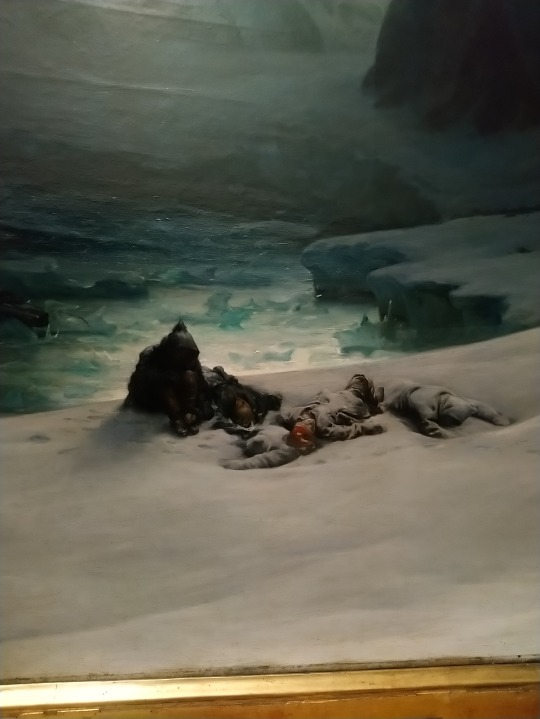
7 notes
·
View notes
Text
DAY 5290
Jalsa, Mumbai Aug 6/7, 2022 Sat/Sun 10:05 AM
🧡 ,
Aug 7 .. birthday wishes to Ef Krishna Kumar and Ef One Narges ..
Ef Sameer Khare from Nashik .. happy birthday to you for Aug 5 ..
Love and happiness to all .. 🏵️🏵️🏵️🌿
✨
love and greetings to all and the care and safety .. from the Ef ..
and to begin with a small correction , that has been pointed out to me ..

.. the picture .. actually .. isn't shown in a “hair dressing salon” 🙈 .. it's shown in the LOUVRE MUSEUM OF PARIS .. World's largest Museum .. and the Home of some of the best-known works of art .. including the Mona Lisa ..
.. the picture is displayed on the wall of portraits by Harcourt Studio .. one of the renowned and luxurious studios of photography in France .. situated at the Carrousel du Louvre in Paris ..
Harcourt Studio has launched a Photo Booth there at the entry of the Louvre Museum ..
The portrait shown on the board .. was shot by Harcourt in the year 2009 .. when I was invited for the opening of one of the events at the newly opened structure , which has all its pipes running outside the building .. forget its name .. for purists a most damaging architectural deed, especially in the city of Paris, renowned for its architectural glory and magnificence .. but then trust the French to do things differently .. the reaction to the glass pyramid build in the open courtyard of the LOUVRE, had equal amount of dislike by the purists and it took a while before it was finally accepted .. as an element of modern art or modern expression ..


... ahhh , got the name of the structure .. its
Centre Pompidou , Paris, France .. An "inside out" building in the historical centre of Paris, featuring Europe’s largest modern art museum.

punch in the name on the Goog and find some amazing pictures of the modern art museum .. and this was where the pic of moi was put up ..
.. and it has been a few days of emotional and amazing collects from the Social Media when Ef have put up pictures of letters written by Babuji to friends .. one of them informing the friend of Babuji’s decision to get married to Ma .. and later on written to announce my birth .. its dated 1942 .. !!
And there is so much the desire to get the originals .. working on it ..
... but there is so much to work on and do , and ne’er the time or the dedicated time to attend to them .. in particular the work to be done on Babuji .. and am at a loss of how to go about it ..
.. his poetry to be recited to be put to music to be put to film and video ..
his thesis on WB Yeats for the literary world .. to be read out and put in audio form ..
his translations of various poets and poetries of other countries ..
his own translated works of the tragedies of Shakespeare in the graph and style of the bard but in Hindi, the first of its kind ..
his rendering of the Bhagwad Gita in the translate language of the Tulsidas Ramayan , called JanGita .. and the desire to put it to music .. another first of its kind ..
and then to be able to do justice to this .. to find the dedicated time people and venue for its compiling and documenting .. a final finality for posterity , for the World of the written word , for the people who have read remembered and admired his works ..
it has been painful each day to think of this and have no answers ..
answers to birthday reminders wedding reminders anniversary reminders, autograph hunters, selfie insisters .. and many more in acknowledge demands
but Babuji .. ??
Alright no more laments ..
just prayers .. for all .. for peace and calm ..

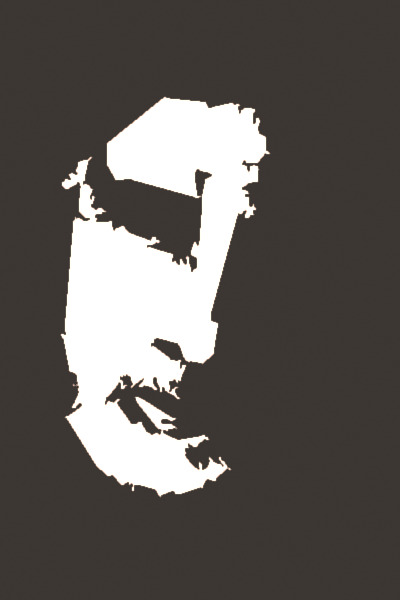

Amitabh Bachchan 🌷
127 notes
·
View notes
Text
La Scultura del giorno: la Ninfa Salmacis di Bosio
La scultura del giorno che vi propongo oggi è la Ninfa Salmacis, scolpita dall’artista monegasco Francois Joseph Bosio fra il 1824 e il 1826.
La ninfa realizzata in stile neoclassico in candido marmo, oggi appartiene al Museo del Louvre di Parigi e fu commissionata all’artista il 3 agosto del 1826 dal Ministero della Maison du Roi.
L’opera venne presentata al prestigioso Salone di Parigi del…

View On WordPress
#antonietta bandelloni#art#artblogger#arte#bellezza#english#inartwetrust#La scultura del giorno#life#Louvre#madeinitaly#masterpiece#paris#sculpture
12 notes
·
View notes
Text
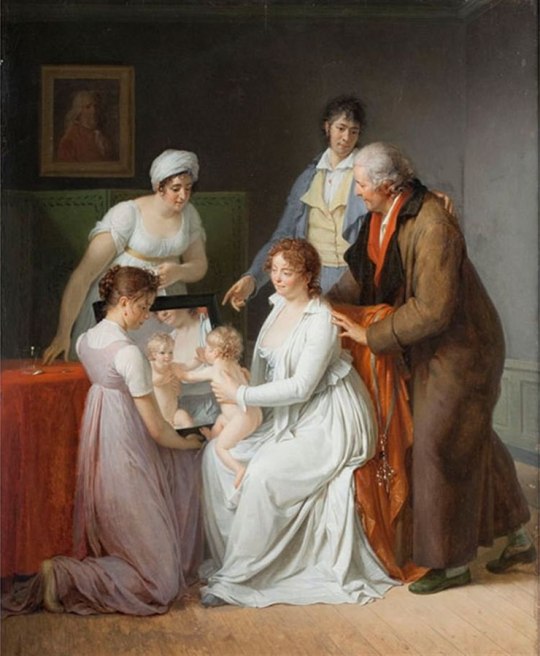
Jacques Augustin Pajou - Portrait of the Artist's Family - ca 1802
oil on canvas, 63 x 52 cm, Musée du Louvre
Jacques-Augustin-Catherine Pajou (27 August 1766, Paris - 28 November 1828, Paris) was a French painter in the Classical style.
His father was the sculptor, Augustin Pajou. Nothing is known of his childhood. In 1784, at the age of eighteen, he became a student at the Académie royale de peinture et de sculpture. Four attempts to win the Prix de Rome were unsuccessful.
In 1792, he became a member of the Compagnie des arts de Paris, organized by the Louvre, alongside the painter Louis-François Lejeune as well as the future economist, Jean-Baptiste Say. While stationed with the regular army in Sedan, he wrote numerous letters to his friend, François Gérard. which express his initial enthusiasm, but gradually turn to boredom, disillusionment and physical exhaustion.
After being demobilized, he participated in creating the "Commune générale des arts", an institution designed to replace the Académie Royale. He served as Secretary for the Commune's President, Joseph-Marie Vien. In 1795, he married Marie-Marguerite Thibault (1764-1827). Under the First Empire, he was commissioned to paint a portrait of Maréchal Louis-Alexandre Berthier, which may still be seen at Versailles. In 1812, he was awarded a gold medal for his depiction of Napoleon offering clemency to the Royalists who had taken refuge in Spain.
In 1811, at the urging of François-Guillaume Ménageot, who had become apprised of the precarious financial situation facing the sculptor David d'Angers, Pajou wrote a letter to the mayor of Angers, demanding that material aid be given to the sculptor. The aid was granted and was considered a lifesaver for d'Angers, who went on to win the Prix de Rome for sculpture and spend several years at the French Academy in Rome. In 1814, he painted three tableaux celebrating the Bourbon Restoration. They were displayed at the Salon and it is possible they were seen by Napoleon.
He resigned from most of the associations of which he was a member in 1823, citing poor health. In a letter from that period, he says that he was "cruelly tormented for a year by a continual tremor." He died in 1828 and was interred at the Cimetière du Père-Lachaise.
His son, Augustin-Désiré Pajou also became a well-known painter.
3 notes
·
View notes
Photo

MWW Artwork of the Day (6/7/23)
Étienne-Maurice Falconet (French, 1716-1791)
Pygmalion and Galatea (1763)
Marble sculpture, 83 cm. high
Musée du Louvre, Paris
The myth of Pygmalion, so popular in eighteenth-century France, was fittingly to be carved by Falconet. The result appeared at the Salon of 1763, to be enthusiastically received by everyone. The galant connotations of the theme added to its popularity. This was probably the greatest moment of public success in Falconet's career, though it did not coincide with his finest work. The group's popularity was connected less with its merits than with its subject, which inspired several paintings and Rousseau's scene lyrique, among other theatrical pieces, as well as some philosophic interpretation. The myth expressed, above all, the idea of woman coming to life under a man's hands; it had seldom been utilized by sculptors, and Falconet's Pygmalion kneels in rapture before what amounts to a double act of creation.
For more of Falconet's work, see this MWW Special Collection:
https://www.facebook.com/media/set/?vanity=TheMuseumWithoutWalls&set=a.371960352909340
12 notes
·
View notes
Photo
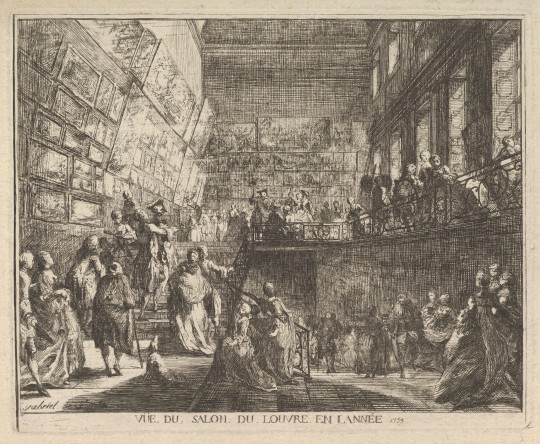
Vue du Salon du Louvre en l'année 1753. 1753. Credit line: Wrightsman Fund, 2006 https://www.metmuseum.org/art/collection/search/371222
#aesthetic#art#abstract art#art museum#art history#The Metropolitan Museum of Art#museum#museum photography#museum aesthetic#dark academia
2 notes
·
View notes
Text
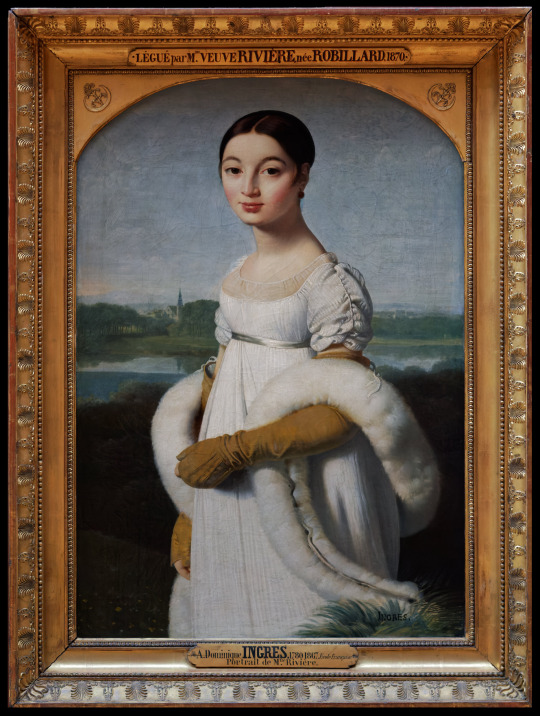
Jean Auguste Dominique Ingres (French, 1780-1867)
Portrait de Caroline Rivière (1793 - 1807), Salon de 1806
Musée du Louvre
#ingres#jean ausguste dominique ingres#art#french#french art#france#fine art#european art#classical art#europe#european#oil painting#fine arts#europa#mediterranean#female portrait#female#portrait#brunette#woman#black hair#black eyes#1800s#1700s#classic art#traditional art#painting#women in art
32 notes
·
View notes
Text
Le vol de la Joconde

C'est le 21 août 1911 que lors d'une de ses rondes, un gardien du Louvre constate la disparition du plus célèbre tableau du monde La Joconde de Léonard de Vinci. Contre toute attente, l'employé ne donne pas immédiatement l'alerte. En effet, la simple idée du vol du portrait de Mona Lisa semble si incongrue qu'il pense que l'oeuvre a simplement été déplacée par les conservateurs. Ce n'est que le lendemain que les responsables s'alarment, et que la police est tardivement prévenue. L'affaire est si grave que les autorités renforcent les contrôles aux frontières. Les soupçons portent d'abord sur le poète Guillaume Apollinaire, mis en cause quelques années plus tôt dans le vol de statuettes ibériques que son ami Géry Pieret avait revendu à Picasso. Apollinaire est emprisonné à la Santé du 7 au 11 septembre 1911, avant d'être blanchi. Deux ans durant, la presse internationale spécule sur l'affaire. l'incroyable histoire de cette disparition achève de porter au pinacle la célébrité de Mona Lisa. La revue L'Illustration promet cinquante mille francs pour qui rapporterait le tableau dans les locaux du journal. L'écrivain italien Gabriele D'Annunzio revendique le forfait au nom de son nationalisme italien. Il n'est pas pris au sérieux. Pourtant, le mobile était le bon, le voleur était un ouvrier italien nommé Vincenzo Perugia, qui travaillait au Louvre. Il conserva le tableau pendant deux ans, caché dans sa chambre, avant de le proposer, contre 500 000 lires, à Alfredo Geri, un antiquaire Florentin. Ce dernier examina le tableau le 11 décembre 1913 en compagnie d'un ami, Giovanni Poggi, directeur du musée des Offices. Et ils prévinrent la police. Le 13 décembre 1913, jamais en retard d'un scoop, le New York Times publiait la première déposition de Perugia : "Souvent, pendant que je travaillais au Louvre, je m'arrêtais devant la peinture de Vinci, et j'étais humilié de la voir ainsi en terre étrangère. La subtiliser fut très simple. Je n'avais qu'à choisir le moment opportun. Un matin, j'ai rejoint mes camarades décorateurs au Louvre, j'ai échangé quelques mots avec eux, puis je suis entré dans le salon où la peinture était accrochée. Il était désert. La peinture souriait devant moi. En un instant, je l'avais décrochée du mur. J'ai déposé le cadre dans l'escalier et glissé le panneau sous ma blouse. Tout s'est fait en quelques secondes. Personne ne m'a vu, personne ne m'a suspecté…" Tenant compte de ses intentions patriotiques, le tribunal condamna Perugia a un an et quinze jours de prison, peine qu'il n'accomplit pas dans sa totalité. Le 4 janvier 1914, La Joconde retrouvait le Louvre, sous une plus étroite surveillance
15 notes
·
View notes
Photo
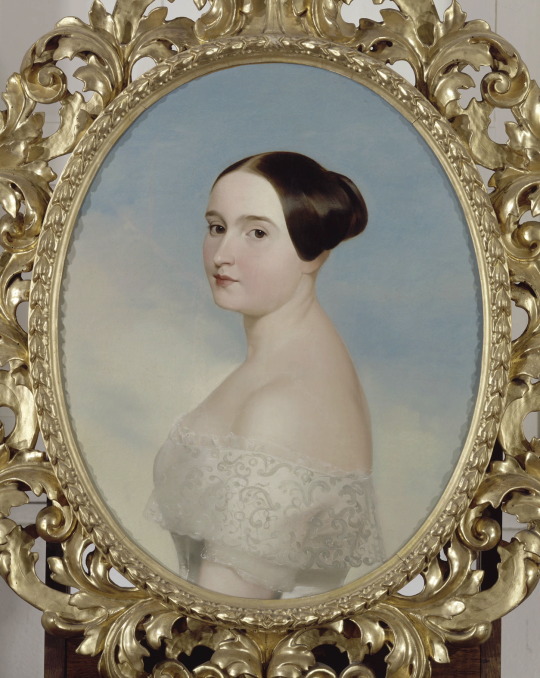


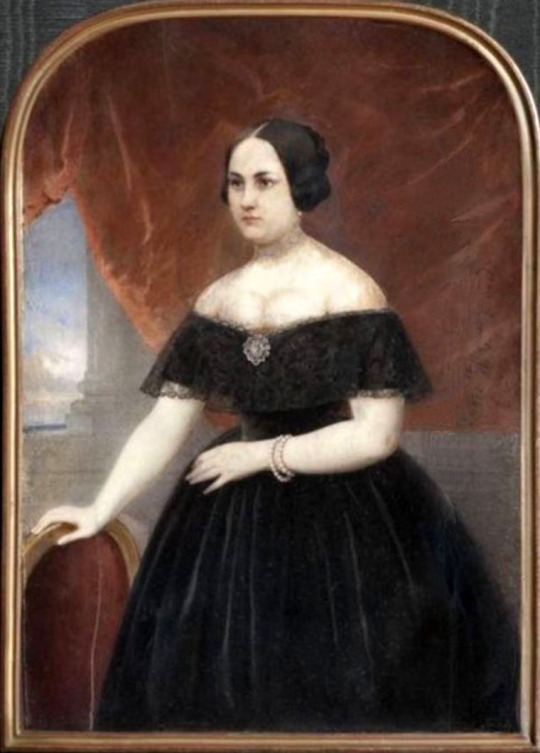
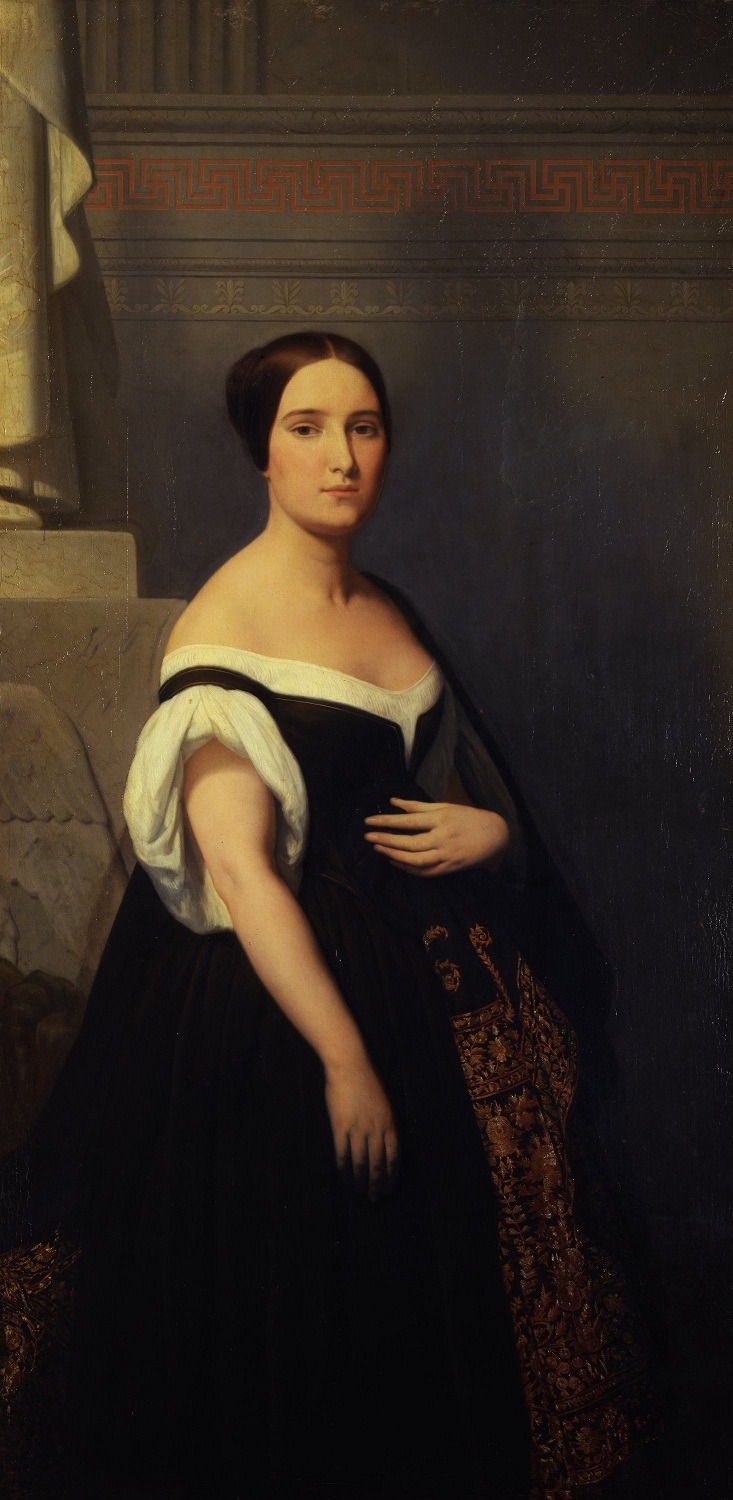
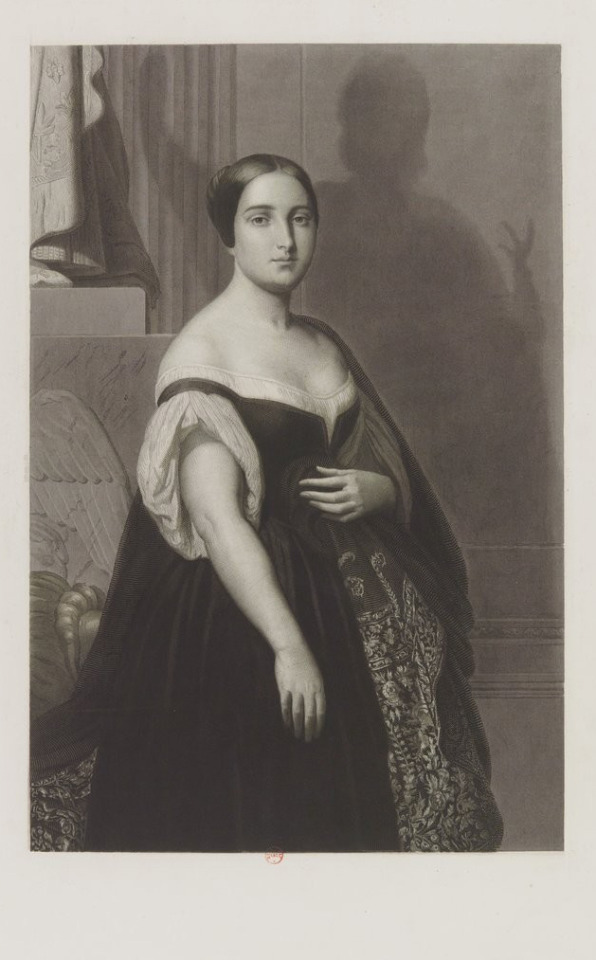


Earlier images of Princess Mathilde Bonaparte:
Web references often quote her as saying about Napoleon I – "If it weren't for him, I'd be selling oranges on the streets of Ajaccio." But Napoleon Bonaparte was her uncle so she was granted the title Princess. She married Prince Demidoff, unsuccessfully. She was prominent during the Second Empire, hosting a prominent salon during and after the fall of the Second Empire. While not as beautiful as Empress Eugénie, she did project an aura of glamour. She was a candidate for marriage to Napoleon III, but some of the images posted here reveal someone who would have had no patience for the Emperor's infidelities. She married the poet Claudius Marcel Popelin when Prince Demidoff died in 1870. She died in 1904.
Top: 1840 Mathilde by Giuseppe Bezzuoli (Musee Fesch - Ajacco Corsica, France). From the lost gallery's photostream on flickr 1254X1575 @200 545kj. One of the best-known portraits of Napoléon III’s niece.
Second row: 1840 Portrait presumed to be the young Princess Mathilde by Eugene Louis Lami (Musée du Louvre - Paris, France) UPGRADE From liveinternet.r//users/4000579/post370046381 800X950 @96 162kj
Third row left: ca. 1840 Mathilde Bonaparte by Tesaert d'après Reinhield (private collectio) photo - Gérard Blot. From RMN; fully sharpened 2080X2580 @144 5Mp,
Third row right: Mathilde wearing a dark dress by ? (location ?) fixed fold-type flaw From liveinternet.ru/users/4000579/post370046381 760X1060 @300 160kj.
Fourth row left: 1844 Princess Mathilde by Ary Scheffer (Galleria d'arte moderna di Firenze - Firenze, Toscana, Italy). From Wikimedia 733X1500 @3200 283kj.
Four row right. Portrait de la Princesse Mathilde by Luigi Calamatta. From Bibliothèque nationale de France Web site 629X1013 @72 166kj.
Fifth row left: Mathilde self portrait (Château de Compiègne - Compiègne, Oise, Hauts-de-France, France) photo - Stéphane Maréchalle, From photo.rmn.fr/CS.aspx?VP3=SearchResult&VBID=2CMFCI01W2SYD&SMLS=1&RW=2287&RH=1312 1408X2014 @144 2.9Mp.
Fifth row right: S. A. I. Madame la princesse Mathilde by Jean Aubert after Eugène Giraud. From Bibliothèque nationale de France Web site; redid margins & removed print and 2 spots w Pshop 955X1325 @72 326kj
#early Victorian fashion#Romantic era fashion#1840s fashion#Mathilde Bonaparte#Princess Mathilde#Mathilde Demidoff#straight hair#chignon#V décolletage
20 notes
·
View notes
Text

Enterrement au Front
Jean Louis Forain (1852–1931)
French, Early Modern, Impressionist
1917
oil on canvas
In this somber painting made at the height of the First World War, a priest stands in a wind-blown cassock reading from a book, presumably the Bible, at the foot of a shallow rectangular grave site. Beside the grave stands a uniformed soldier holding a rustic cross and facing the priest, and at the lower right are seen a piece of lumber and various unidentified objects. The setting in which the burial occurs appears to be a beach at the edge of the sea, all seen against a leaden grey sky. The painting is signed and dated at the lower right: Forain 1917.
Jean Louis Forain was born the son of an ornamental painter on October 23, 1852, in Reims. Arriving in Paris with his family at the age of eleven, the young Forain started receiving drawing lessons from the painter Jacquesson de la Chevreuse and soon began to copy Old Masters at the Musée du Louvre. There, he was noticed by the sculptor Jean Baptiste Carpeaux, who asked him to join his studio. However, at age 17 he was expelled from Carpeaux's studio, and his furious father threw him out of the family home. To keep from starving, Forain first painted portraits of newly deceased people, then started selling illustrations to small satirical newspapers. His talents as a painter were recognized and respected by the intimate group of Impressionists he frequented, which included the two artists Forain considered his masters, Edouard Manet and Edgar Degas. In 1879, Forain took part in the 4th Impressionist Exhibition (Exhibition of Independent Artists) along with Mary Cassatt, Degas, Claude Monet, Camille Pissarro, and others. In 1880 and 1881 he participated in the 5th and 6th Impressionist Exhibitions. In 1884 the Salon accepted his painting, The Buffet. During World War I, Forain became a member of the French army's Camouflage Corps, a group of artists who documented the course of the war in art. Forain was made a Commander of the Legion of Honor and a member of the Royal Academy of England. He died in Paris in 1931.
Dumbarton Oaks
9 notes
·
View notes
Text
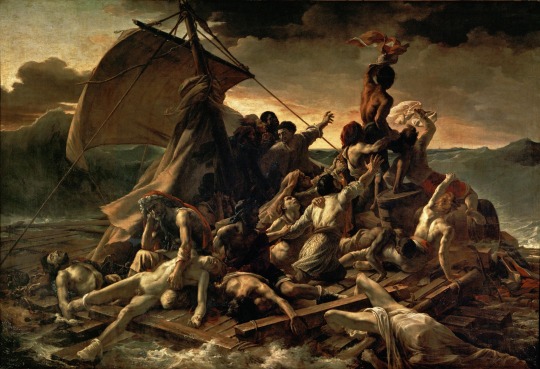
Le Radeau de la Méduse, 1819, Oil on canvas, 491x716 cm, Paris, musèe du Louvre
Theodore Gèricault was a french painter, from the Romanticism movement.
From a wealthy family, in 1798 he moved to Paris where he attended the atelier of Vernet and then Guèrin, but his training and stile was heavily influenced by Gros and the study at the Louvre of Flemish, XVIII century Dutch and Venetian painting. In 1816 he traveled to Italy, where the study of the works of Raphael, Michelangelo and caravaggio greatly influenced his mature style.
Back in Paris after the italian grand tour he met Delacoix. One of his last travel was in Englan, in 1821, where he learned about the free, non academic painting of Constable and Lawrence. With this knowledge he contributed to the overcoming of the academic tradition in France.
In addiction to his production of studies, painting and lithographs, he modeled some interesting figures in wax.
The painting: Le Radeau de la Mèduse
Painted in 1818, was presented at the salon in 1819, a controversy painting, for the fusion made with romantic dramatic intensity between classical composition and dynamic rapresentation of reality.
The subject of the painting was a rather dramatic event in the history of the french navy. In 1816 the Meduse, a frigate, set sail from the cost of France to reach Senegal. Arriving in sight of Cap Blanc, the inexperience of the captain prevented the recognition of a infamous, but rather known sandy bank off the coast of Mauritania. So the ship tilted to one side, the captain and all the equip tried to save the ship, but every attempt failed. The only thing remained to do was to abandon the ship and reach the cost of mauritania. With only 6 lifeboats they had to set up a makeshift raft. On it boarden 149 man and 1 woman. It's a dark story what happen next, fights boke out, there were suicides, murders, desperation and cannibalism. After 13 days adrift finally what remained of the draft was spotted, of the 150 people, only 15 were found alive, wich five of them died during the night of the rescue.
In 1817 two survivors wrote a book telling what happened during those 13 days in the ocean.
And here it's were we start talking about the painting.
Gericault decided to paint all the shades of physical pain, moral anguish in the mass of people on the raft, from the father in foregroud, intoxicated by the pain of losing his son, to the men who are trying to make themself more visible to the ship in the backgorund. The gugantic dimensions and the epic style were finally used to rapresent the sufference of normal people. The scene is a romantic metaphore of human life, in perpetual struggle with adversity and destiny divided between despair and hope, life and death.
The scene is constructed onto diagonal lines with two arriving ponts, one is the raft shaft, the other the shirt blowing in the wind. Theres a muvement, a vertical tension to the horizont. The wind blow in the opposite direction, moving the raft away from salvation. The red accents of the light onto varius object make the drammatic scene more dramatic.
The painting is romantic in his intent and subject, but his form is classic, the drawings define the bodies, the chiaroscuro define the dinamic. The bodies are like heroes and atlethes, organaized in a piramid structure, at the point of the pyramid theres a body that remainds of the belvedere torso, an antient statue very known during the neoclassicism period.
When i was 13 i read about this event, without realizing it, one of my favorite book is Ocean sea by Alessandro baricco, an italian wrtiter, who described what happened on the raft in the middle of the book. Five years forward i was studing art and i came across this bauty, and i hiperfixated on it (as one does) and now the book, wich already was one of my favorite just made more sense.
#meduse#art academia#dark academia#art#art history#light academia#painting#academia#chaotic academia#classic academia#theodore gericault#the raft of the meduse#the raft of the Medusa
17 notes
·
View notes